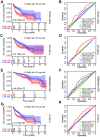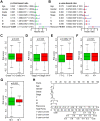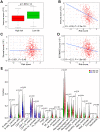Identification of prognostic aging-related genes associated with immunosuppression and inflammation in head and neck squamous cell carcinoma
- PMID: 33232279
- PMCID: PMC7803584
- DOI: 10.18632/aging.104199
Identification of prognostic aging-related genes associated with immunosuppression and inflammation in head and neck squamous cell carcinoma
Abstract
Aging is regarded as a dominant risk factor for cancer. Additionally, inflammation and asthenic immune surveillance with aging may facilitate tumor formation and development. However, few studies have comprehensively analyzed the relationship between aging-related genes (AGs) and the prognosis, inflammation and tumor immunity of head and neck squamous cell carcinoma (HNSCC). Here, we initially screened 41 differentially expressed AGs from The Cancer Genome Atlas (TCGA) database. In the training set, a prognosis risk model with seven AGs (APP, CDKN2A, EGFR, HSPD1, IL2RG, PLAU and VEGFA) was constructed and validated in the TCGA test set and the GEO set (P < 0.05). Using univariate and multivariate Cox regression analyses, we confirmed that risk score was an independent prognostic factor of HNSCC patients. In addition, a high risk score was significantly correlated with immunosuppression, and high expression of PLAU, APP and EGFR was the main factor. Furthermore, we confirmed that a high risk score was significantly associated with levels of proinflammatory factors (IL-1α, IL-1β, IL-6 and IL-8) in HNSCC samples. Thus, this risk model may serve as a prognostic signature and provide clues for individualized immunotherapy for HNSCC patients.
Keywords: aging-related genes (AGs); head and neck squamous cell carcinoma (HNSCC); immunosuppression; inflammation; prognosis.
Conflict of interest statement
Figures









Similar articles
-
Development and validation of a fourteen- innate immunity-related gene pairs signature for predicting prognosis head and neck squamous cell carcinoma.BMC Cancer. 2020 Oct 20;20(1):1015. doi: 10.1186/s12885-020-07489-7. BMC Cancer. 2020. PMID: 33081731 Free PMC article.
-
Six Glycolysis-Related Genes as Prognostic Risk Markers Can Predict the Prognosis of Patients with Head and Neck Squamous Cell Carcinoma.Biomed Res Int. 2021 Feb 10;2021:8824195. doi: 10.1155/2021/8824195. eCollection 2021. Biomed Res Int. 2021. PMID: 33628816 Free PMC article.
-
A Novel Ferroptosis-Related Gene Signature to Predict Prognosis in Patients with Head and Neck Squamous Cell Carcinoma.Dis Markers. 2021 Nov 22;2021:5759927. doi: 10.1155/2021/5759927. eCollection 2021. Dis Markers. 2021. PMID: 34853622 Free PMC article.
-
Long noncoding RNAs in head and neck squamous cell carcinoma: biological functions and mechanisms.Mol Biol Rep. 2020 Oct;47(10):8075-8090. doi: 10.1007/s11033-020-05777-w. Epub 2020 Sep 10. Mol Biol Rep. 2020. PMID: 32914266 Review.
-
Systematic review on the current knowledge and use of single-cell RNA sequencing in head and neck cancer.APMIS. 2021 Nov;129(11):619-625. doi: 10.1111/apm.13173. APMIS. 2021. PMID: 34561896
Cited by
-
An Update on the Immunotherapy for Oropharyngeal Squamous Cell Carcinoma.Front Oncol. 2022 Mar 15;12:800315. doi: 10.3389/fonc.2022.800315. eCollection 2022. Front Oncol. 2022. PMID: 35372036 Free PMC article. Review.
-
Identification of new head and neck squamous cell carcinoma subtypes and development of a novel score system (PGSscore) based on variations in pathway activity between tumor and adjacent non-tumor samples.Comput Struct Biotechnol J. 2022 Sep 1;20:4786-4805. doi: 10.1016/j.csbj.2022.08.057. eCollection 2022. Comput Struct Biotechnol J. 2022. PMID: 36147682 Free PMC article.
-
The Aging-Related Prognostic Signature Reveals the Landscape of the Tumor Immune Microenvironment in Head and Neck Squamous Cell Carcinoma.Front Oncol. 2022 May 10;12:857994. doi: 10.3389/fonc.2022.857994. eCollection 2022. Front Oncol. 2022. PMID: 35619896 Free PMC article.
-
Identification and verification of aging-related lncRNAs for prognosis prediction and immune microenvironment in patients with head and neck squamous carcinoma.Oncol Res. 2023 Mar 1;31(1):35-61. doi: 10.32604/or.2022.028193. eCollection 2023. Oncol Res. 2023. PMID: 37303739 Free PMC article.
-
Depiction of Aging-Based Molecular Phenotypes With Diverse Clinical Prognosis and Immunological Features in Gastric Cancer.Front Med (Lausanne). 2022 Feb 1;8:792740. doi: 10.3389/fmed.2021.792740. eCollection 2021. Front Med (Lausanne). 2022. PMID: 35178409 Free PMC article.
References
-
- Hill SJ, D’Andrea AD. Predictive potential of head and neck squamous cell carcinoma organoids. Cancer Discov. 2019; 9:828–30. 10.1158/2159-8290.CD-19-0527 - DOI - PubMed
Publication types
MeSH terms
Substances
LinkOut - more resources
Full Text Sources
Medical
Research Materials
Miscellaneous

